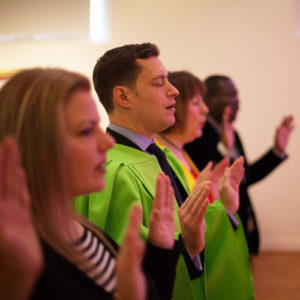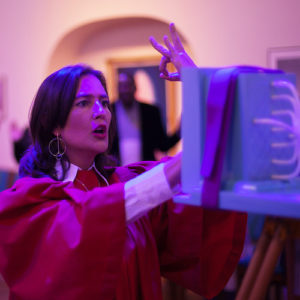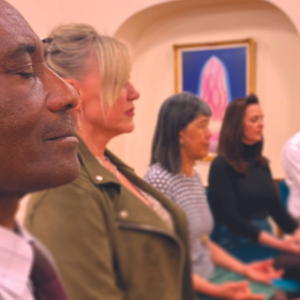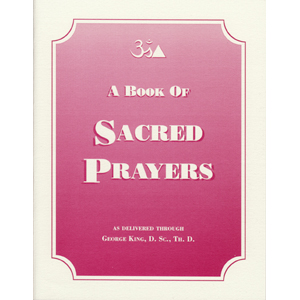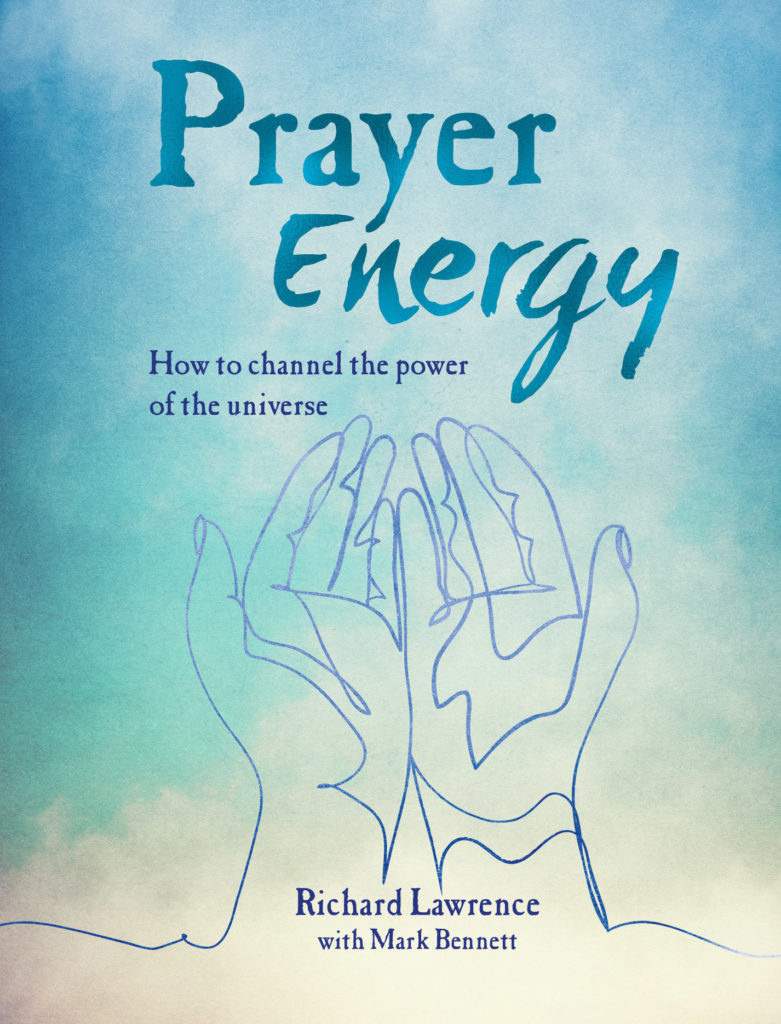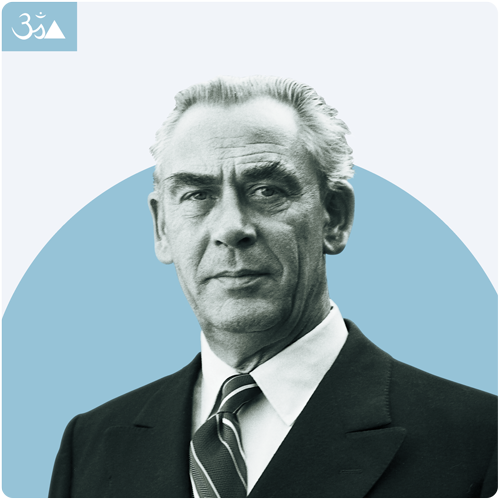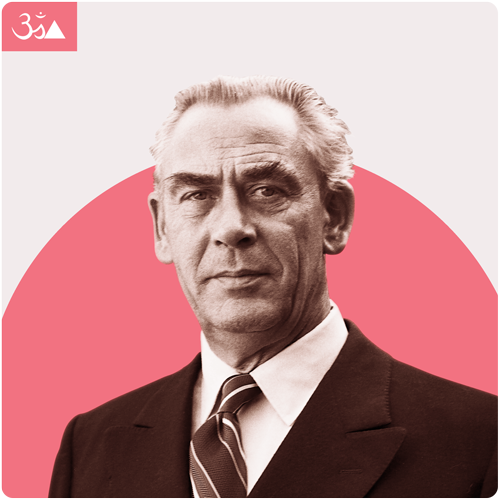Make your prayers really work
Discover more about how to make your prayers really work by subscribing to our 10-part class featuring practical exercises, experiments and audio demonstrations.
How to pray
Below are two edited extracts from the book Prayer Energy describing a simple but powerful prayer technique:
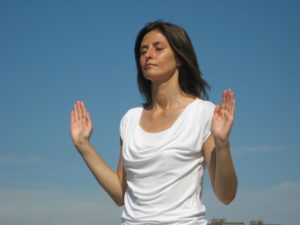
The posture for the prayer technique
The Prayer Technique
This is a simple way of sending spiritual energy to those in need.
- Stand or sit quietly for a few moments with your back as straight as is comfortable, breathing deeply and evenly, with your eyes closed. Then raise your hands so they are roughly parallel with the top of your shoulders, palms facing outwards, fingers together.
- Visualise a scintillating white light coming down from above you into your head, charging every cell of the brain with its vibrant power. Take this energy down through your neck and shoulders, on through the chest and out to the front of the heart chakra, a few inches in front of the breastbone. Charge this centre with the bright, white light.
- Then visualise the light coming from the shoulders down through the arms and into the hands. Now direct this energy
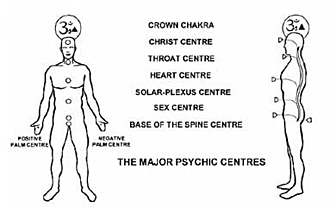
Depiction of the location of the chakras
outwards, so you have a stream of healing white light flowing out from your palms and heart chakra. You are now ready to say your prayer, which is normally done out loud. You can direct the energy wherever you choose, whether it be to a person who is ill or to a region in crisis, visualising the person or the region not as they are, but as they could be – glowing with spiritual happiness and wellbeing.
- When you have finished, brush your right hand over your left, away from you. This acts as a seal for the energy and is symbolic of completion of the practice. These hand positions are known in the east as mudras, a word particularly associated with Tibet.
Even without mention of a Divine Source, this technique will still have some power, but I would strongly recommend that a request is made of the Divine Source – whatever you like to call it. This can help to raise the prayer’s energy and empower it by the conscious recognition of the truth that the energy we are using comes from a source greater than ourselves.
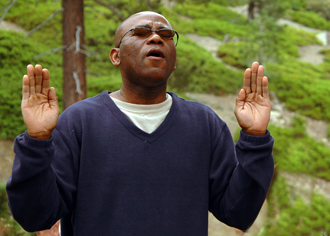
Demonstrating the prayer technique on a Holy Mountain.
Likewise, it is a good thing to end a prayer with a few words of thanks to the Divine Source. Our thanks are not needed, of course, but since we have received something, expending some energy in thanks acts as a token repayment, giving a certain balance to the ritual being performed.
Thankfulness also acts as a positive affirmation that a prayer will be effective – otherwise there would be nothing to be thankful for. This confidence in your ability, providing it is not presumptuous, serves to empower the prayer.
Another reason to offer thanks is that it is a way of saying “This is over,” helping you to detach from the action, which you should always do rather than worrying about your prayer’s effectiveness. Such concern, despite being well intentioned, can interfere with the uplifting energy you have sent out, since all our thoughts produce mental energy and the mental energy of doubt is counterproductive.
* * *
Say it with feeling
For prayer to work properly it should be expressed with sincerity and feeling, and the whole act should be performed with single-minded concentration. We should not pray as though talking at a party or gossiping with a friend. Prayer is not a telephone call to your mother, or a request made to your boss, a priest, movie star, politician, or even a president – it is an appeal to the Divine Source. Imagine, metaphorically speaking, that you had the opportunity to have an audience with God, if that’s how you want to refer to the Divine Source, and say what it is you want and how you feel – this is virtually what is happening when you pray. If you mumble your prayers, or say them without feeling, you are as good as saying, “I don’t have to make any effort when expressing myself to God.” In fact, this shows a lack of appreciation for the Divine Source of all creation and, therefore, for the most important part of yourself, and will considerably limit the power of the prayer.
Jane Austen said: “Grant us grace, almighty Father, so to pray as to deserve to be heard.” She made a good point. Technically, all prayers “deserve to be heard,” because they invoke and transmit a certain amount of energy, but the quantity and quality of the energy will increase dramatically when we start to pray dynamically.
Try saying ‘The New Lord’s Prayer’ or, indeed, any other positive prayer, in as expressive a manner as you can. Don’t worry about seeming silly. Just give it all you’ve got. Make it as dynamic in intensity, but not volume, as a scream you might let out if someone ran over your foot, and as wholehearted as when football fans cheer for their favourite teams, although exerting more self control. You don’t have to be very loud – the important thing is not to hold back at all. Imagine that your very life depends on every single word. Don’t be melodramatic or over emotional. Put genuine feeling and love into it. This is the first step.
Controlling prayer energy
The next step – when you’ve got used to saying a prayer out loud with all the feeling you can muster, thus invoking and transmitting much more energy than you did before – is to train yourself to gain more control over the energy. This will enable you to act as a channel for even more, and better quality, energy which will, in turn, make your prayers better than ever.
Prayer should be a balanced symphony of opposites, a melody of yin and yang, a harmonious blend of light and shade, each bringing the other to life. To gain more control over prayer energy you should be:
- gentle, but also definite and firm
- passionate, but controlled and not too emotional
- filled with compassion and want the result of the prayer with all your heart, and yet also be detached from it
- imploring, yet confident of the outcome of the prayer
- humble, and yet feel as powerful as the Divine Source, which is our essence
With the development of these qualities your prayers should become quieter without losing any of the intensity displayed when praying loudly. A good way of cultivating these opposite attributes is to alternate the volume of your prayer a little, so that some words and phrases are louder than others, and some words may be barely audible at all.
Praying like this is not easy and can take a lot of practice. Remember you are making yourself a channel to allow the energy to flow through you. You are not trying to force it. Your body should not be tense to the point of shaking. Instead, you should be physically relaxed, while trying to maintain the posture described in the prayer technique.
Often you may not feel in the mood to pray at all. In fact, when we feel at our lowest, prayer can be a struggle, but this is the very time when praying can do the most good. So try it. Just do one short prayer. This can change your mood so quickly that you may well feel like carrying on and saying more prayers as soon as you’ve finished the first one.
Prayer and personality go hand in hand. Everyone has an individual way of praying, even when adhering to the same principles, as listed above. What is interesting, though, is that our true personality seems to be revealed by prayer – after all, prayer has to be genuine to mean anything at all. It has to come from the soul. Someone who is apparently very passive might suddenly come to life during prayer, becoming almost unrecognisable. This is that person’s real personality. The one he or she usually shows is merely the surface of the still, deep ocean of his or her true spiritual nature.
Learning to pray is not just the acquisition of an incredibly useful, practical skill. It is a tool for personal transformation and discovery. As your ability improves you will find that you improve throughout your life in countless different ways. It will, in short, bring out the very best in you.


